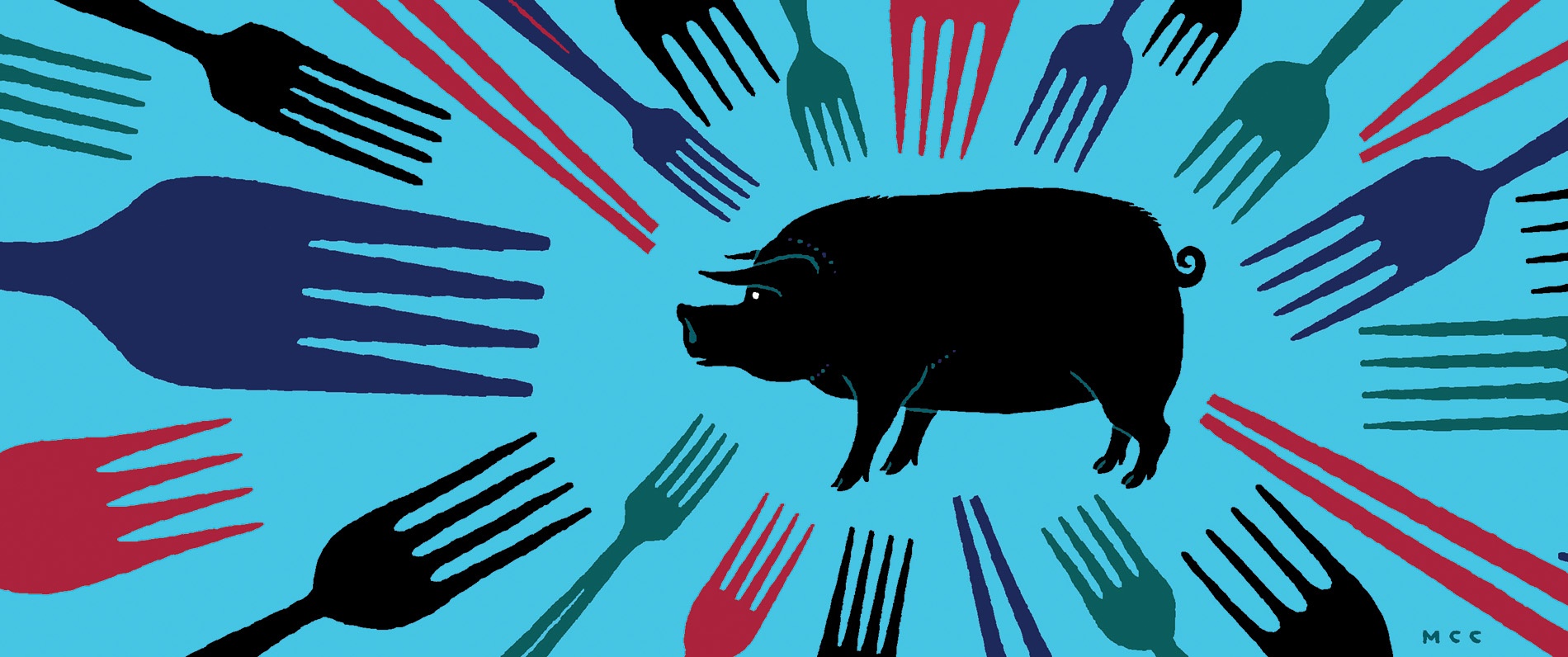
All the Pigs in China
To make good food choices these days, you have to sort out global trade, politics, and environmental issues. Even experts can’t do it.
Everybody eats,” says Dawn King, a senior lecturer at Brown’s Institute for Environment and Society. “And so in some way, shape, or form, everybody is somewhat vested into our food system.” Food has always been political, but eating seems to be getting increasingly complicated. Just to get cereal on the table you have to navigate global bread basket concerns over Ukraine, labor conflict in the U.S., and how to source and what to call the white fluid you pour on top—never mind the shameful legacy of the sugar industry. The rest of breakfast is no easier: Is your coffee shade-grown? Is your faux sausage made with GMO soy? Will there be bananas in 20 years?
“Food is so holistic, and just so intermingled and intertwined with all sorts of other sectors and policies and issues,” says King, who chaired the Rhode Island Food Policy Council and still leads its climate change workgroup. King’s own recent research shows that if you give SNAP recipients the opportunity, they love to buy fresh and local vegetables. The same local farms that can provide food to low-income communities can preserve open space for stormwater management and wildlife habitat, while sequestering carbon into the soil. From good food policy flows healthier communities.
But keeping track of political, environmental, and health issues around food choices can be exhausting for the consumer. Take the seemingly simple question of where your food comes from. The USDA has a country of origin labeling (COOL) system, but it’s uneven. Fresh and frozen fruits and vegetables and wild and farm-raised fish and shellfish require COOL labels. Beef, pork, turkey, milk, cheese, wheat, and rice do not. And while most food retailers have to comply, most restaurants and cafeterias do not.
“Food systems are so complicated that any idea that the individual should be responsible for doing the research into how their food is produced is not acceptable,” argues Brian Lander, the Stanley J. Bernstein Assistant Professor of History and Environment and Society. An expert on pork production, he was bewildered by the challenge of trying to eat more sustainable seafood. “I realized you have to understand both entire ocean ecosystems and also the whole economy of fish production and processing—which is impossible,” says Lander. “I still can’t understand what’s going on. This needs to be done through policy, by experts, and not treated as an individual choice issue.”
Sustainable choice: a fluke?
Still, well-meaning shoppers and diners try to make good choices. The system isn’t helping, says Ross Cheit, director of undergraduate studies in political science. “I don’t think the power of the fork is very powerful at all,” he says, referring to the potential ability of consumers to effect systemic changes, “and I think it has no power in the seafood realm.” Cheit’s food politics class is usually oversubscribed, and his next book—due in 2024—will explore policy and politics in U.S. fisheries management.
For the conscientious consumer of beef or chicken, Cheit acknowledges, there’s a reasonable checklist to help make decisions: conventional, organic, humanely raised, grass fed. Seafood is more complex. “I’m really kind of stunned, constantly, at how complicated this system is,” says Cheit.
There are certification systems for U.S.-caught seafood, but much of what we eat is imported. Use Seafood Watch, the Monterey Bay Aquarium’s website that labels fish with categories like “best choice,” “good alternative,” or “avoid,” and fluke seems like the best choice. But look closer and you’ll see there are five listings for fluke and only line-caught won best choice. “The difference is something that not a single consumer in America could ever know,” says Cheit. “Who in the supply chain can verify how anything was caught?”
Chinese takeaway
The West invented a style of living that’s alluring but also very resource-intensive, says environmental history professor Brian Lander. The large populations of China and India want to level up. As a result, pork is now the most produced and consumed meat in the world, a dietary shift with major economic and environmental impact. But “you can’t have 1.4 billion people who all drive Buicks and eat pork every day,” Lander says. “It’s starting to show the limits of our model for how human societies can work.”
“The story of pork’s rise is also a story of China’s rise,” says Mindi Schneider, a specialist in agricultural modernization who collaborates with Lander and recently became a lecturer at the Institute for Environment and Society. Understanding how it happened may be a key to global sustainability.
To see the extent to which the world’s agricultural systems and corporations are interconnected, zoom in on those pigs in China. When China suffered an outbreak of African swine fever in 2018-19, it resulted in a huge cull. For the next couple of years, China imported pork primarily from the United States, the European Union, and Brazil. Those countries ramped up production to meet that huge demand, but now that China’s re-upped its herd, the rubber band has snapped back. We saw some of the whipsaw effect on the industry’s labor force when COVID shone a light on dismal meatpacking conditions.
That’s just one ripple in the larger pond of China’s rapidly industrializing food production. What happened in the U.S. over more than a century—massive displacement of people out of farms and the capitalist consolidation of agriculture—is unfolding over a few decades in China.
“The scale of globalization now is so much more massive that it’s not just quantitatively different,” says Schneider. “It’s fundamentally different from anything that existed before.”
And it ties us all together. For instance, Chinese meat production is fed by soybeans from the New World. China pays for its imports with profits from selling us consumer goods made cheaper by the exploitation of its labor force and environment. These ecological and human costs underlie the questions posed by Western meat consumption. How can the West consume at one level and insist that China consume less? “It becomes an equity issue,” says Schneider. “Whose lives count? Whose bodies matter in the production of all this meat?”





